The Jeff: Reborn
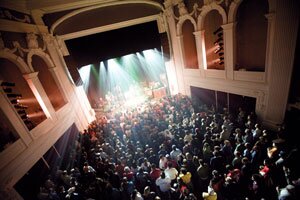
PHOTO BY TOM DALY
I am a life-long Charlottesville resident, and while this town has nurtured my love of history, architecture, and entertainment, only one building merges my interest in all three– the Jefferson Theater, which has risen almost from ashes again.
After almost three and a half years and a multi-million-dollar renovation, the building regained much if not all of its glory when it sprang back to life last November 27. It wasn't until just a few weeks ago, however, that the finishing touches– which bring it to whole new heights of entertainment-- were finally applied.
This is my story and its story.
Always live entertainment
The Jefferson Theater began its entertaining life in 1912 as a "combination house," a vaudeville and silent movie theater. A consortium of local bigwigs purchased an existing bank building on Main Street, bought up pieces of the backyards of the adjacent structures, and proceeded to construct the theater that extends all the way back to Water Street.
In 1915, the building literally rose from its ashes after most of the interior was destroyed by a fire. It would be reborn several times: as a movie theater for the "talkies," as a classic film showcase, as a twin-cinema discount theater (with occasional live shows), and now its current incarnation as a live music venue.
In the earliest days when entertainment options were limited, and horse-drawn transportation was still big in Charlottesville, the shows at the Jefferson were literally front-page news in the Daily Progress.
During the automobile age, anyone could just drive by to read the marquee. It offered first-run films, including Disney movies— I saw my first there— and other family fare. Just drop off the kids and shop.
All this activity happened in a structure that had so many extra rooms that it is one of Charlottesville's earliest "mixed-use" buildings. Back in the 1960s, the building housed a pool hall in the basement, a restaurant to the right of the entrance foyer, and a tailor shop on the second floor over the lobby. But as downtown declined amid growing suburban shopping competition, so did the Jefferson. Both became seedier, as did the on-screen fare.
When Main Street was thriving, however, so did the Jefferson. The films were as much respite from real life as the once-projecting marquee was a respite from the rain. Then, there were two things that differentiated the Jefferson Theater from theaters of today. Like most movie theaters of the time, it had one person in a small ticket booth under the marquee, instead of a multi-person box office attached to the lobby. The other feature– unique to the Jefferson– was a large glow-in-the-dark clock, left of the proscenium arch surrounding the screen. As a child, I got so accustomed to it, that the Paramount became the theater without a clock.
As a teen, I got a temporary job at the Jefferson handing out "vomit bags" as part of the promotional efforts for a schlocky B-movie called Mark of the Devil. In 1969, four local men bought the Jefferson and changed its name to The Cinema. The cultural skid continued with X-rated late shows, earning the theater a smirking nickname: "The Skinema." On weekend nights, before the advent of home video rendered all this public embarrassment unnecessary, passersby could see giggling couples sheepishly standing in line for tickets.
Throughout the 1970s, the building deteriorated to the point that it wasn't unusual to see swallows swooping past the screen and rats rummaging for a snack. During a 1974 presentation of Andy Warhol's Frankenstein— shown in 3-D– there was a scene in which two children explore a castle cellar as a 3D bat flies toward the audience. Having seen plenty of actual wildlife there, I dove for the floor.
A year later, the manager penned a memo to his business partners: "I just don't think that things can get worse." Business got so bad that on April 22, 1976– with Elvis on Tour as its last feature film– the Cinema closed its doors.
An old tour
The next incarnation was "The Movie Palace." Launched in 1978 to show classic film in direct competition to the Vinegar Hill Theatre, which had locally pioneered the concept two years earlier, The Movie Palace made over the lobby with cheesy black-and-white wallpaper of some very 1970s-looking people.
During that renovation, I received permission to explore the building from top to bottom. Inside the projection booth, I found a projectionist talking with two Jefferson veterans, one of whom was John Kase, legendary for running the Charlottesville operations of the Neighborhood Theaters chain and its predecessors for over 40 years. During the next hour or so, Kase (a World War II vet who died just last year) regaled me with stories of the Jefferson's heyday.
Kase pointed out that the upper opera boxes near the orchestra pit were removed during the Depression when the theater focused on movies.
He told me how African-American patrons were steered to the left-side stairway and up to the mezzanine, and he also talked about a second balcony, never used during his time, above the mezzanine. When I questioned this, he showed me how Jim Crow-era restrooms had been carved out of attic space and even out of a stairway landing– long ago rendering the upper balcony, with its original bench seating, off-limits to everyone.
I had known that the 1941 movie, Virginia– starring Fred MacMurray and Madeleine Carroll– had been filmed in the area. What I hadn't known was that a set was built on the stage of the Jefferson for a scene in the movie. This was the same stage on which Harry Houdini had performed in 1924 during the vaudeville era.
For many years, it wasn't unusual for stars to make personal appearances at movie theaters, and the Jefferson had welcomed many. Some had claimed that the Three Stooges had graced the stage, but it turned out that the slapstick trio's 1947 appearance in Charlottesville was a block to the west, at the now-demolished Lafayette Theater, which was replaced by Rose's and is now York Place.
Kase surprised me again with tales of the Jefferson as a rehearsal stage for Broadway shows. With the C&O railroad tracks just one block to the south and cheap non-union labor available, stars like Eddie Bracken (Hail the Conquering Hero) and Eddie Albert (of television's Green Acres fame) could practice in preparation for New York's Great White Way
Within months of my tour, the attempt to run classic films fizzled as unprofitable and, Vinegar Hill Theater having won that round, first-run films returned to the Movie Palace.
In the summer of 1981, I was again temporarily employed there, this time as the emcee of a 10-week kiddies' matinee series which needed "Spiffy the Clown." Each week, I took the stage before the movie for a few minutes of juggling and shenanigans. Hey, a guy's gotta work!
Early 1984 saw extensive changes. The small box office outside was removed, and more importantly, the mezzanine was walled off and turned into a second auditorium with its own screen.
Downstairs, a new projection booth was built for the existing main screen, and the two cinemas trudged on, barely getting by while showing discount movies. Apartments and businesses– including a basement game room and, later, what was probably Charlottesville's first Indian restaurant– Nirvana– helped pay the mortgage.
In 1992, the owners of the building had stopped paying the mortgage, and the property was sold on the courthouse steps. Hook editor Hawes Spencer attended the foreclosure auction.
His account: "I heard it would be cheap, I loved the building, and I didn't want to see it cease being a theater."
Under his ownership, the theater reclaimed its original name, the Jefferson Theater, while discount movies continued to make the place a continuing favorite as a date spot. Occasionally, it served other purposes, including First Night Virginia each New Year's Eve and Roger Ebert's first local shot-by-shot workshop, an event for the 1992 Virginia Festival of American Film.
One memorable concert took place on December 12, 1993. Still a rising rock star, Dave Matthews performed an acoustic show with friend and occasional side-man, Tim Reynolds, in what might have been their second-ever public appearance. While the duo would later sell out much larger venues, Spencer recalls seeing a half-empty auditorium.
Operating on a shoestring, Spencer rented out all the space he could– including art studios in the basement and wild dance parties called "raves" on the stage. Innisfree World Artisans took the Mallfront retail space; the four apartments upstairs were upgraded, and an enterprising crepe-maker turned Kase's old office on Water Street into a take-out restaurant called the Flat.
Throughout his ownership, Spencer had offers for the building, but would-be buyers typically wanted the theater space for apartments, shops, and offices. Fortunately for Charlottesville, music mogul Coran Capshaw eventually agreed to buy it and keep it as a performance hall. The sale was made, and Jefferson Theater ceased operation as a movie theater on June 15, 2006.
A new tour
Several times since the re-opening I have stood– like many passersby– and peered into the lobby. Recently, I took a tour with manager Kirby Hutto, who oversaw the renovation and who also manages the Charlottesville Pavilion for the media-shy Capshaw.
The crumbling laminate concession stand is gone, and in its place is a door to a new restaurant called "Cinema Taco," which serves take-out Southwestern food during events, as well as lunch and dinner.
We walk past the stairs and the original restrooms. No dramatic changes; those lie on the other side of the swinging steel theater doors.
Gone is the wall with the cartoonish black and white wall paper— as is the projection booth. To the right is a sensuously sprawling bar with red curtains as a backdrop. It faces an open deck ahead that offers clear sightlines to the stage. We walk past tables and chairs to the railing. On either end of the railing are steps down to the dance floor.
Yes, dance floor. Many folks are surprised that the seats are gone and replaced with a wooden floor that declines slightly as it reaches the stage. Hutto explains that the old floor– actually four of them– was removed. (Apparently, when the former owners had a problem with a floor, they just added supports and another layer of floor over it.)
As the tour reaches the floor, I become speechless. I had always somewhat noticed the plaster work, but the auditorium had been painted in muted tones, effectively hiding the "Adamesque" classical design.
The 1915 rebuild was overseen by Richmond-based architect C.K. Howell, whose other theater credits include Richmond's Empire and National, as well as the Academy of Music in Lynchburg, and the renowned Lucas in Savannah.
Surprising details
Now painted white, the plaster trim— with garlands, wreaths, smiling cherubs, columns, and musical instruments— practically bursts from the eggplant walls.
"I was surprised that the plaster details survived as well as they did," says an understated Hutto, who oversaw some plaster recasting.
The biggest surprises, according to Hutto, also led to some of the biggest challenges: fitting all the new mechanicals into the "nooks and crannies." There's all-new lumping, sprinklers, ventilation, and a sound system with its own subwoofer room built under the stage.
"We were finding new walled areas," explains Hutto, "after a year or two into the process."
Comparisons to the Paramount Theater are inevitable. Both 20th Century theaters were renovated and reopened as live entertainment venues in the last five years. Both are beautiful in their own way. The Paramount is more ornate and larger (at 1,000 capacity) but was built as a movie theater with a much wider auditorium– while the much taller Jefferson is so narrow that a 1912 the Daily Progress branded it a "corker."
When asked how The Jefferson (which holds 750) will fit into the entertainment scene, Hutto opines: "It complements The Paramount. The Jefferson aims toward rock."
He mentions that City officials have already seen it luring people to the Downtown Mall. "Some businesses," says Hutto, "are already happy about that."
Hutto claims the acoustics at the Jefferson are better too. As for what it all cost, he says the $7.5 million figure cited in an old press release from Ash Lawn Opera (with whom the Jefferson ended not partnering) isn't right, but that he's not at liberty to give the correct figure.
One of my favorite moments was standing in front of the stage and peering up. Not only can I see the mezzanine— which had been walled off in the 1984 twinning— but also the upper balcony, which had been hidden for at least 60 years. I can't wait to get up there.
The tour ends in the basement bar, just a few steps down from the back of the dance floor. One of the two brick walls surrounding this bar is the original back wall of the 1901 bank building. Nearby are two new large restrooms, a coat check area, and the staircase back to the front lobby.
I part from Hutto to check out the balconies. Both offer seating and steep sight-lines to the stage, but that's where the comparisons end.
The mezzanine holds about 150 in stadium-style seating, complete with beverage holders; the balcony holds about 50 on three levels with "club-style" seating of small tables with two chairs.
I heard a great story about the hip poet who lived up here throughout the 1990s. One night in 1993, when he was living temporarily in the basement electrical room, C.W. Hlad was walking home on Water Street from his dishwashing job at the C&O. Spotting smoke pouring from an adjacent structure, he raced to a payphone in a kiosk on the Downtown Mall and called 911.
Spencer emphatically points out how the fire chief said, after his crews extinguished the blaze, that the early response to the Nowell's Catering fire saved not only the Jefferson but the whole block. (Hlad ended up becoming a filmmaker whose work recently debuted at the South by Southwest festival and enjoyed its Charlottesville premiere at the Paramount.)
Hutto says that the Jefferson's last major renovation is the small glass box office that took shape last month under the marquee lights.
Although one of the Jefferson's old projectors was put on display and its old popcorn warmer rewired to keep empanadas toasty at the Cinema Taco restaurant, many film aficionados will mourn the end of movies at the Jefferson. However, Hutto isn't ruling them out for special events.
What else we can look forward to seeing at The Jefferson?
"Variety," answers Hutto. "We are looking forward to working with various festivals, which could include the Virginia Film Festival, the Virginia Festival of the Book, and the photography festival, among others."
When asked what happens when the Charlottesville Pavilion is open, he replies: "There may be fewer concerts because both venues share some of the same staff."
So, what does Hutto want people to know about the Jefferson?
"It's back," says Hutto. "People will be shocked to see it."
He's right. When I attend the January 22 Cheap Trick concert, I hear almost as many kudos for the venue as for the band with the classic live album from Budokan.
Hutto says that the Jefferson hopes to have an open house later this year, and if that happens, I hope you check out this place. You'll find out it was no cheap trick, but it just might be magical.
#
1912-1915 construction
Architects: W.W. Keenan, C.K. Howell
General contractor: King Lumber, Charlottesville Lumber
Cost: $40,000 (1912)
Opening night: October 21, 1912
Headliner: William Hodge in The Man from Home (a comedic play)
Opening night tickets: $1, $1.50, and $2
Impressive claim: a full change of interior air every 12 minutes
2009-2010 renovation
Architects: Gate Pratt of Limehouse Architects and Robert Nichols and Cecilia Hernandez Nichols of Formwork Architecture
General Contractor: Jack Horn of Martin-Horn
Cost: undisclosed (but at least a few million)
Re-opening night: November 27, 2009
Headliners: Sons of Bill and Jason Isbell & the 400 Unit(rockers)
Opening night tickets: $15, 17
Impressive claim: a $200,000 sound system including a room housing the subwoofers
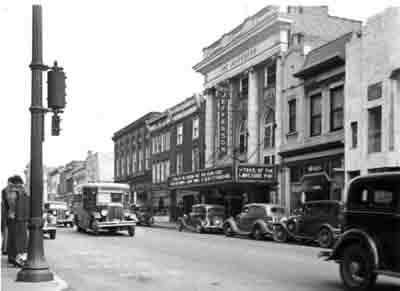
Circa 1935: The Jefferson originally had an svelte iron marquee, replaced with a bigger one in the 1960s, and then de-marqueed in the 1970s.
PHOTO UNKNOWN
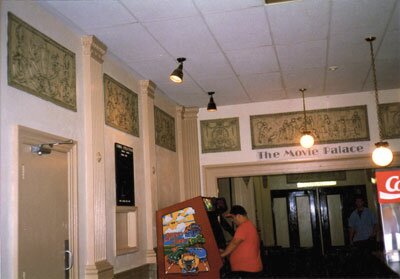
Circa 1991: The Jefferson's handsome coffered lobby ceiling was obscured by drop tiles and 1970s hanging globe lamps–- not to mention the sounds from the Bump 'n' Jump arcade game.
PHOTO COURTESY SAM DELAURA

A tiny Jim Crow-era restroom was built on the landing to the then closed-off upper balcony and carried– under layers of paint and stickers– the command, "Men Only."
PHOTO BY HAWES SPENCER
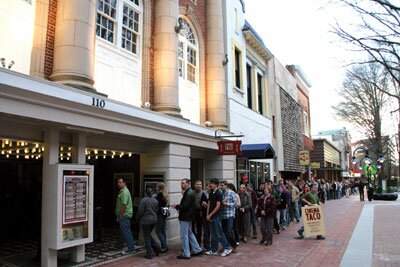
Popular shows now draw eager fans who queue up to snag precious near-stage standing room.
PHOTO BY HAWES SPENCER
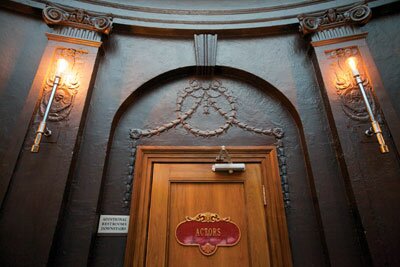
Layers of paint and glue from the 1970s wallpaper made painting the elliptical room in period colors so difficult that the designers opted for a textured wall treatment.
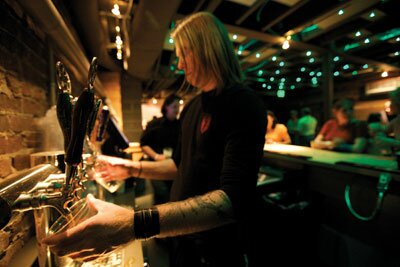
The basement bar used to be the site of a rat's nest– a real one.
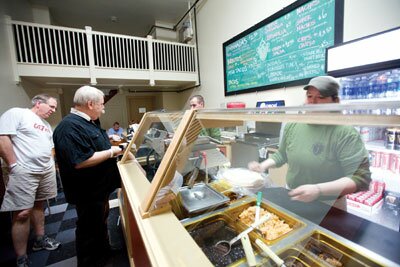
The old retail space has become "Cinema Taco," with a direct lobby link.
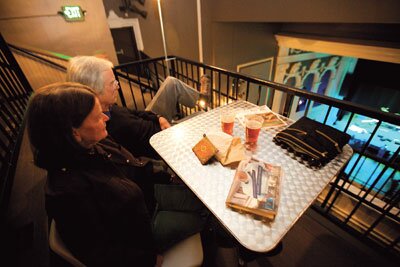
The old upper balcony now has chairs and tables high above the stage.

Many big names– such as Harry Houdini– have performed on the Jefferson Theater stage, but 2010 has already seen Trey Anastasio and the man who opened here for Shannon Worrell in 1995, Ben Folds.
#
7 comments
Great article, Brother! Only one point of contention. In the "Tour" section, you mentioned being "speechless." In the almost 55 years of knowing you, I've never known you to be at a loss for words! LOL!!!
Wait, Cheap Trick played the Jefferson and this did not merit a Hook cover story?
What is this world coming to?
Great article Carrol, as you know I work security at the Jefferson now. I am proud to be part of its long history!!
"X-rated late shows, earning the theater a smirking nickname: "The Skinema." Spent many a night in the upper reaches of the Jeff-my former husband, a projectionist, for the late shows- usually sparsely attended. The movies were far tamer than much of what is currently seen on TV. What I loved most, in those days, was the old world charm, still present in all the seediness and dust. Thankful, that Mr. Spencer stood on the steps of the courthouse and saved this grand old lady, as the theater she was meant to be. Many remnants of Charlottesville's past have been destroyed, but this one has been reborn for all to enjoy. Congratulations to all who made this possible.
Nice piece!! It's nice to read something by a local whose history goes back further than "I remember when Dave was a bartender".
Don't forget that The Cinema showed Kung Fu movies, Shaft and Blacula, and the nearly skinless Barbarella (much to my teenage disappointment).
Great article! I learned even more history from this article than I did from the production manager who just happens to be my son!
I think that the Jefferson has been great so far, but I feel as though some of the staff could lighten up a bit, especially one bouncer in particular! Your supposed to be selling fun. So next time I go there I hope to see the staff take their frowns and turn them upside down!
Have fun!